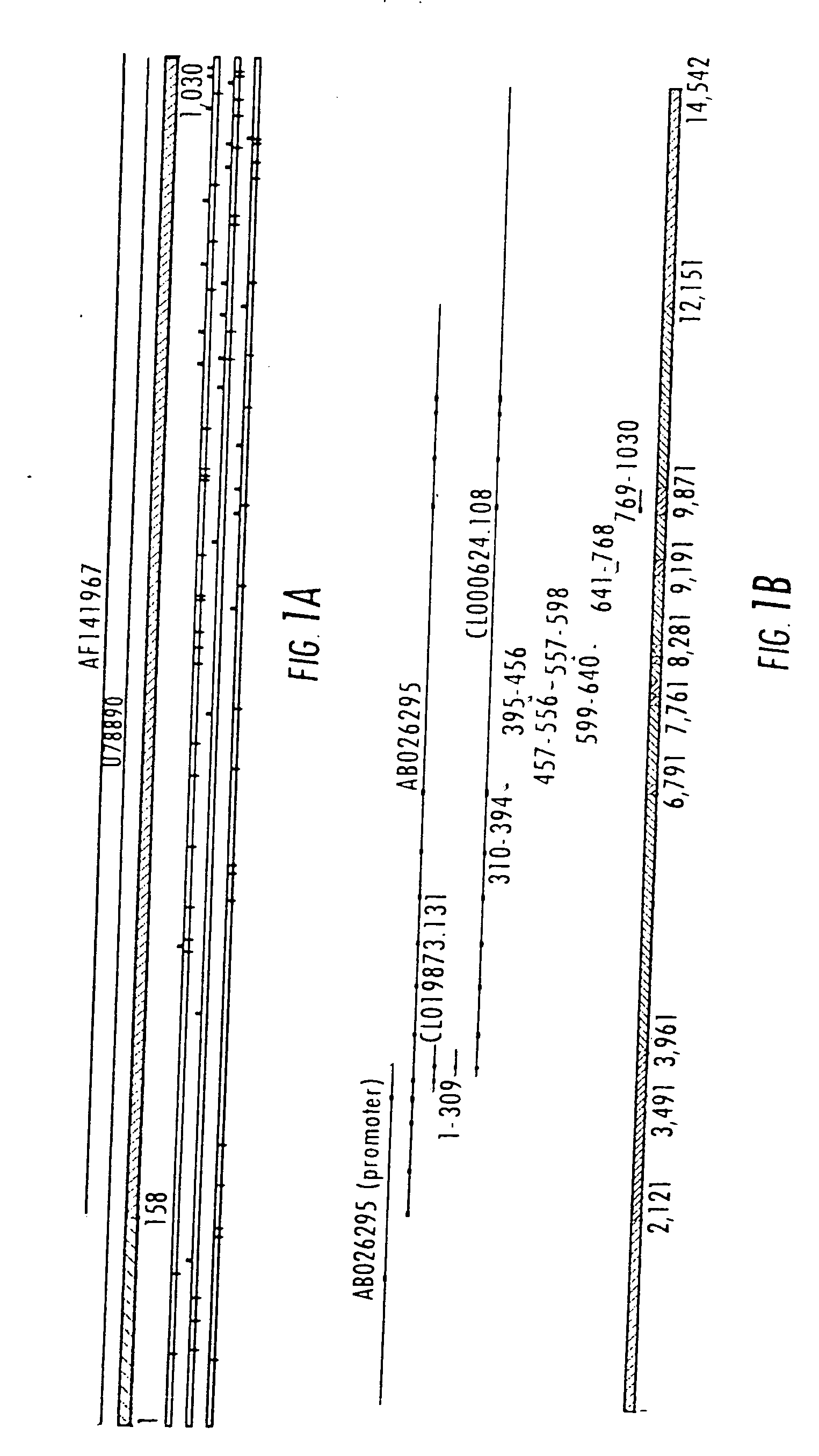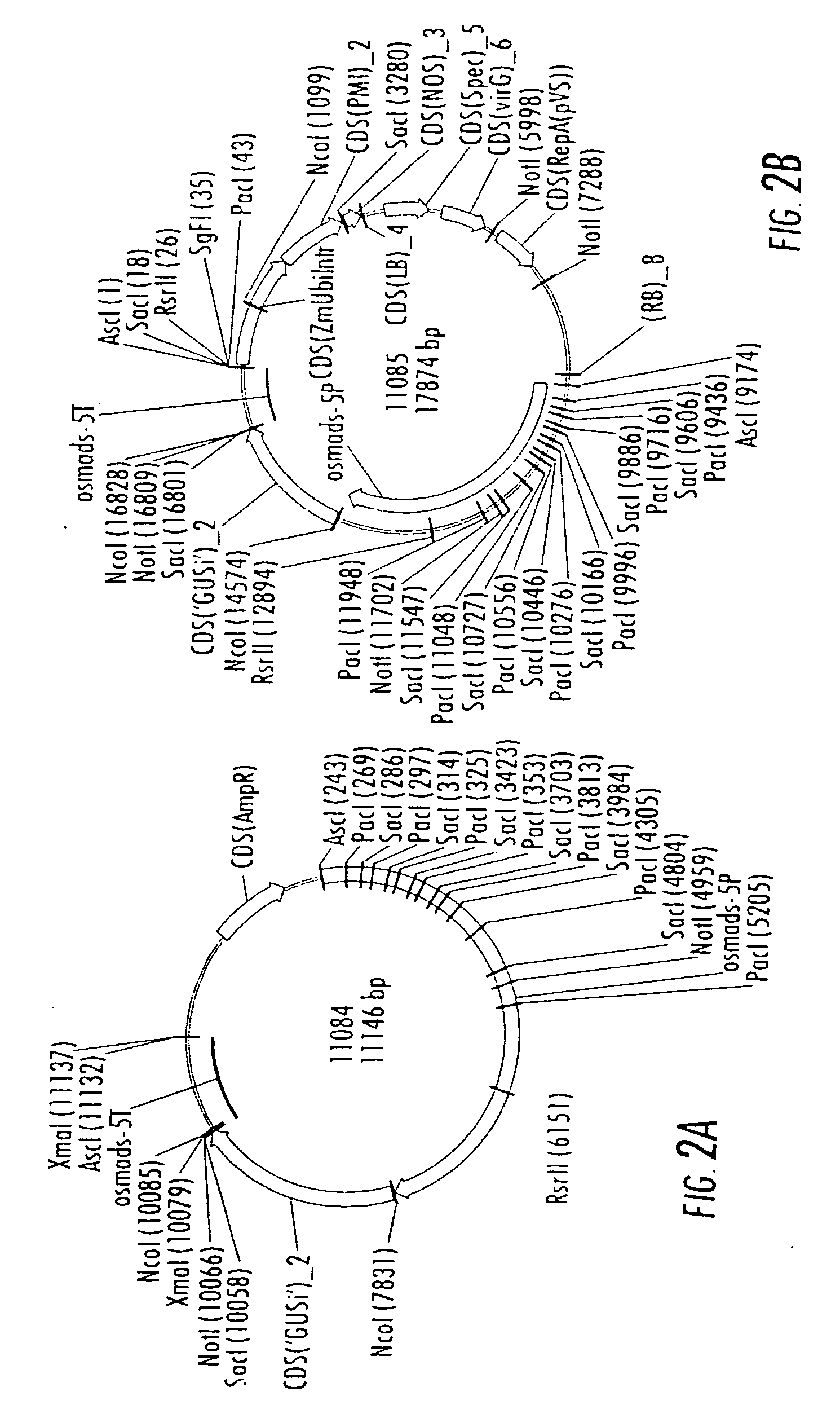Regulatory sequences for expressing gene products in plant reproductive tissue
a gene product and regulatory sequence technology, applied in biochemistry, sugar derivatives, organic chemistry, etc., can solve the problems of insufficient expression levels of gene products, especially those directed to expression in specific tissues, difficult to identify and specific regulatory regions, and inability to integrate them into a robust trait delivery platform. , to achieve the effect of increasing the sink strength, enhancing the capacity for small molecule uptake, and increasing the sink strength
- Summary
- Abstract
- Description
- Claims
- Application Information
AI Technical Summary
Benefits of technology
Problems solved by technology
Method used
Image
Examples
example 1
Method of Constructing Expression Cassettes Comprising Regulatory Sequences from the MADS Gene Family
1. Identifying target MADS genes.
2. Identifying high quality sequence for both the target's genomic DNA (gDNA) and cDNA.
3. Identifying the target gene's open reading frame on the cDNA. In general this is the longest open reading frame.
[0068] 4. Using a candidate gene's cDNA sequence to annotate gDNA sequence and marking positions of the translation start codon, translation stop codon, introns, exons, the 5′-untranslated leader and the 3′-untranslated sequence. As is known in the art, marking the translation start codon and the translation stop codon identifies the 5′-regulatory sequence and the 3′-regualtory sequence of the gene. According to the present invention, the promoter, which includes the promoter regulatory sequence, is the sequence that extends approximately 1.5 to 2.5 kb upstream from the translation start codon, wherein the 3′-regulatory sequence of the present in...
example 2
1. Construction of the Assembly Vector pNOV6901 Containing the β-glucuronidase (GUS) Coding Sequence.
[0104] A. Preparation of GUS Coding Sequence.
[0105] The β-glucuronidase (GUS) coding sequence Narasimhulu, et al 1996, Plant Cell, 8: 873-886, which includes an engineered intron, was amplified from pNOV5003 in a Pfuturbo polymerase (Stratagene, Cat. No. 600250) reaction. The reaction mixture consisted of 1 μL pNOV5003 miniprep DNA 200 μM dNTPs, 20 μM GUS5 oligonucleotide primer 5′-atggtacgtcctgtagaaacc-3′ (SEQ ID NO 498), 20 μM GUS3 oligonucleotide primer 5′-gatcgagctctcattgtttgcctccctg-3′ (SEQ ID NO 499), 5 μL 10× cloned Pfu buffer and 2.5 Units of Pfuturbo DNA polymerase (Stratagene, Cat. No. 600250) in a final volume of 50 μL. The thermocycling program was at 95° C. for 30 seconds then 10 cycles of (95° C. for 5 seconds, 55° C. for 10 seconds, 72° C. for 2.5 minutes) then 20 cycles of (95° C. for 5 seconds, 57° C. for 15 seconds, 72° C. for 2.5 minutes) then 72° C. for 2.5 min...
example 3
Construction of the OsMADS5 Expression Cassette
[0117] A. Cloning the OsMADS5 5′-Regulatory Sequence
[0118] High-fidelity PCR was used to amplify the OsMADS5 5′-regulatory sequence from rice genomic DNA (gDNA). The 50 μL reaction mixture consisted of 100 ng rice gDNA, 200 μM dNTPs, 1 μL 20 μM oligonucleotide primer OsMADS5-P3 5′-tgagcaggtagccggcgaccaatcgcgag-3′ (SEQ ID NO 460), 1 μL 20 μM oligonucleotide primer OsMADS#5-P2 5′-catactgttacaaaaaagaaaatcagtggaccac-3′ (SEQ ID NO 461), 1 μL 10× Expand High Fidelity buffer and 1 μL Expand High Fidelity polymerase. The thermocycling program was at 95° C. for 2 minutes followed by 40 cycles of (94° C. for 15 seconds, 68° C. for 7.5 minutes) followed by 68° C. for 10 minutes. The 5.4 kb DNA product, encoding the OsMADS5 5′-regulatory sequence, was cloned with the TOPO XL PCR cloning kit. The pCR-XL-TOPO-OsMADS5-5′-gDNA recombinants, containing the OsMADS5 5′-regulatory sequence, were identified by digesting 5 μL pCR-XL-TOPO-OsMADS5-5′-gDNA mi...
PUM
| Property | Measurement | Unit |
|---|---|---|
| pH | aaaaa | aaaaa |
| volume | aaaaa | aaaaa |
| volume | aaaaa | aaaaa |
Abstract
Description
Claims
Application Information
 Login to View More
Login to View More - R&D
- Intellectual Property
- Life Sciences
- Materials
- Tech Scout
- Unparalleled Data Quality
- Higher Quality Content
- 60% Fewer Hallucinations
Browse by: Latest US Patents, China's latest patents, Technical Efficacy Thesaurus, Application Domain, Technology Topic, Popular Technical Reports.
© 2025 PatSnap. All rights reserved.Legal|Privacy policy|Modern Slavery Act Transparency Statement|Sitemap|About US| Contact US: help@patsnap.com



